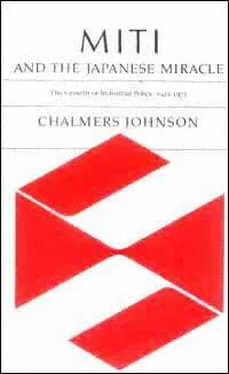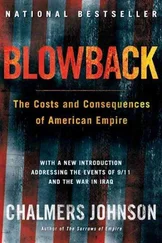Chalmers Johnson - MITI and the Japanese miracle
Здесь есть возможность читать онлайн «Chalmers Johnson - MITI and the Japanese miracle» весь текст электронной книги совершенно бесплатно (целиком полную версию без сокращений). В некоторых случаях можно слушать аудио, скачать через торрент в формате fb2 и присутствует краткое содержание. Год выпуска: 2007, Издательство: Stanford University Press, Жанр: Старинная литература, на английском языке. Описание произведения, (предисловие) а так же отзывы посетителей доступны на портале библиотеки ЛибКат.
- Название:MITI and the Japanese miracle
- Автор:
- Издательство:Stanford University Press
- Жанр:
- Год:2007
- ISBN:нет данных
- Рейтинг книги:3 / 5. Голосов: 1
-
Избранное:Добавить в избранное
- Отзывы:
-
Ваша оценка:
- 60
- 1
- 2
- 3
- 4
- 5
MITI and the Japanese miracle: краткое содержание, описание и аннотация
Предлагаем к чтению аннотацию, описание, краткое содержание или предисловие (зависит от того, что написал сам автор книги «MITI and the Japanese miracle»). Если вы не нашли необходимую информацию о книге — напишите в комментариях, мы постараемся отыскать её.
MITI and the Japanese miracle — читать онлайн бесплатно полную книгу (весь текст) целиком
Ниже представлен текст книги, разбитый по страницам. Система сохранения места последней прочитанной страницы, позволяет с удобством читать онлайн бесплатно книгу «MITI and the Japanese miracle», без необходимости каждый раз заново искать на чём Вы остановились. Поставьте закладку, и сможете в любой момент перейти на страницу, на которой закончили чтение.
Интервал:
Закладка:
kokai
*
hambai seido
) for the steel industryan ingenious system of price rigging invented by the old MCI cadre Inayama Yoshihiro, then a director of Yawata Steel, and Sahashi Shigeru, then the deputy director of the Heavy Industries Bureau.
57
It seemed to some that the FTC would approve anything short of piracy if MITI said it was necessary for Japan's rapid economic growth.
In fact, MITI judged the time was ripe to get rid of the AML altogether. From October 1957 to February 1958 the Enterprises Bureau sponsored a cabinet-level deliberation council on the future status of the AML. Professor Nakayama Ichiro* chaired it. The council stated in its final report that "the stipulations of the AML do not necessarily conform to the proper operation of our country's economy," and that "the public interest is not best served by the legal maintenance of a free competitive order." The council recommended a new law that would allow for the "coordination of investment" and that would encourage mergers to overcome ''excessive competition" among the banking keiretsu.
The new law was introduced in the Diet in October 1958, but it "got lost" in the turmoil surrounding the Kishi government's attempts to revise the police duties law. The following year, according to MITI, interest in abandoning the AML "fell asleep under the pleasant clouds of the Iwato boom."
58
After that the situation began to change subtly. The FTC did not regain its earlier powers, but it stopped losing what powers it had left. Until about 1958 the country was united in its belief that MITI's measures were necessary to regain national economic independence. After that time divisions over the issue began to appear. Most of MITI's subsequent innovations were based on administrative guidancefor example, the coordination of investment that was implemented after the failure of Sahashi's Special Measures Law for the Promotion of Designated Industries (discussed in the next chapter). The FTC continued in existence and finally, during February 1974, it
Page 227
brought its first ever formal complaint against a restraint of trade (discussed in Chapter 8).
Antitrust legislation is a controversial subject. Western theory asserts that it is an indispensable tool of industrial policy in order to maintain competition. Former MITI Vice-Minister Sahashi Shigeru has argued, on the other hand, that Japan's industrial policy, which is hostile to antitrust legislation, has produced higher levels of both competition and growth than the economies of Japan's Western critics.
59
From the point of view of the history of MITI, the major significance of the 1953 reform of the AML was that it almost completed MITI's ensemble of industrial-policy tools. The ministry now had under its control foreign exchange, foreign capital, cartels, banking keiretsu, industrial location, and direct government finance, plus the whole range of activities of the Industrial Rationalization Council. It was almost ready to put the high-growth system into operation, but it still needed some innovations on the tax front and political backing for its particular point of view. It was the harsh recession of 1954 following the Korean War that provided the opportunity to acquire both. As Kakuma has observed, the recession following the special procurements boom was as important as the Korean War itself to Japan's economic development; its influence has too long been unrecognized.
60
During the four years that followed the outbreak of the Korean War in June 1950, the United States pumped some $2.37 billion worth of special procurements into the Japanese economy. This factor, plus the effects of the rationalization campaigns in putting people back to work and of the euphoria that followed the end of the occupation, led to a major consumption and investment boom throughout 1952 and into 1953. Imports of consumer goods and industrial machines skyrocketed. By the end of 1953 Japan was showing a deficit of $260 million in its balance of payments, and the prospects for 1954 looked even worse. Inventories had grown very large, but export sales were sluggish because of the comparatively high prices of Japanese goods and the slowdown in the growth of international trade following the Korean War. The Ministry of Finance and the Bank of Japan had no choice but to tighten credit and cut governmental expenditures, including disbursements from FILP and loans from the Development Bank. Their squeeze on credits and imports caused the recession.
At MITI Minister Okano Kiyohide (May 1953 to January 1954) ordered the International Trade Bureau to cut the foreign currency quotas for the import of food, chemicals, medicine, and textiles from over $8 million during the period April to September 1952, to $4 mil-
Page 228
lion for AprilSeptember 1953. In October 1953 he abolished the quota for these imports altogether, which immediately caused the closing of hundreds of stores in the Tokyo area dealing in consumer goods and led to the reappearance of black markets. Under these circumstances many bureaucratic organizations began to think about how to overcome Japan's dependence on U.S. special procurements, and even Prime Minister Yoshida had to recognize that his piecemeal approach to the economy was not working.
The first important plan came from the Economic Deliberation Agency, where MITI Minister Okano (a former president of the Sanwa Bank) was serving concurrently as director-general and Hirai Tomisaburo * of MITI was working as his deputy director (May 1951 to November 1953). Known both unofficially as the "Okano Plan" (Okano koso*) and by its formal title of "On Making Our Economy Independent" (Waga kuni keizai no jiritsu ni tsuite), the plan outlined a new effort to expand exports. However, in order to do this Okano and Hirai called not just for more rationalization campaigns but also for efforts to restore economic ties with Southeast Asia, a rationalization of the tax system, and a vigorous program to develop import-substitution industries.
The Okano Plan also reflected the view within MITI that the only way to break out of Japan's inevitable balance of payments constraints was through "heavy and chemical industrialization," by which was meant the building of an industrial structure whose export products would have a much higher income elasticity of demand than Japan's traditional light industries. Income elasticity of demand refers to the ratio of the percentage change in the quantity of a product demanded to the percentage change in the income of a group of purchasers. Okano and Hirai were among the first to recognize that as a people's income goes up their demand for food and textiles changes very little but their demand for products such as appliances and automobiles increases proportionally. Their conclusion, even though it flew in the face of Japan's so-called comparative advantages (chiefly a large, cheap labor supply), was that these products were what Japan should be manufacturing if it ever hoped to break out of its dependent position.
61
Prime Minister Yoshida rejected the Okano Plan out of hand, not because of its contents but because it was an instance of "planning," which he felt was appropriate only for socialist countries. Okano left the government, and Hirai returned to MITI as vice-minister (November 1953 to November 1955). But during 1954, as the recession continued and worsened, the ideas of the Okano Plan reappeared in
Page 229
many forms and places. Yoshida was beginning to lose his grip on the Liberal Party, and the man he chose to succeed Okano, Aichi Kiichi, was both an old associate of Ikeda's in the Ministry of Finance (he was Banking Bureau director during the period of zaibatsu dissolution) and a much more influential politician than Okano had been.
On September 6, 1954, Aichi and others in the government led the cabinet into adopting a "Comprehensive Policy for Economic Expansion" (Keizai Kakudai Sogo * Seisaku Yogo*), and this in turn provided MITI, later the same month, with the authority to issue its own fundamental statement of strategy, entitled "Outline of the New International Trade and Industry Policy" (Shin Tsusho* Sangyo* Seisaku Taiko*).
Читать дальшеИнтервал:
Закладка:
Похожие книги на «MITI and the Japanese miracle»
Представляем Вашему вниманию похожие книги на «MITI and the Japanese miracle» списком для выбора. Мы отобрали схожую по названию и смыслу литературу в надежде предоставить читателям больше вариантов отыскать новые, интересные, ещё непрочитанные произведения.
Обсуждение, отзывы о книге «MITI and the Japanese miracle» и просто собственные мнения читателей. Оставьте ваши комментарии, напишите, что Вы думаете о произведении, его смысле или главных героях. Укажите что конкретно понравилось, а что нет, и почему Вы так считаете.












